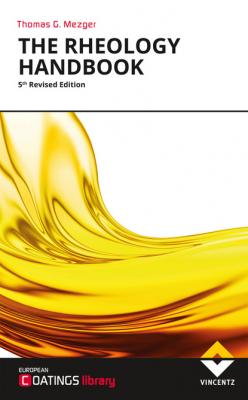The Rheology Handbook. Thomas Mezger
Читать онлайн.| Название | The Rheology Handbook |
|---|---|
| Автор произведения | Thomas Mezger |
| Жанр | Химия |
| Серия | |
| Издательство | Химия |
| Год выпуска | 0 |
| isbn | 9783866305366 |
15 14 Rheologists and the historical development of rheology 14.1 Development until the 19 century 14.2 Development between 1800 and 1900 14.3 Development between 1900 and 1949 14.4 Development between 1950 and 1979 14.5 Development since 1980 14.6 References
16 15 Appendix 15.1 Symbols, signs and abbreviations used 15.2 The Greek alphabet 15.3 Conversion table for units 15.4 References
17 16 Standards 16.1 ISO standards 16.2 ASTM standards 16.3 DIN, DIN EN, DIN EN ISO and EN standards 16.4 Important standards for users of rotational rheometers 16.5 References
18 Author
19 Index
1Introduction
1.1Rheology, rheometry and viscoelasticity
a) Rheology
Rheology is the science of deformation and flow. It is a branch of physics and physical chemistry since the most important variables come from the field of mechanics: forces, deflections and velocities. The term rheology originates from the Greek: rhei or rheo meaning to flow [1.1]. Thus, rheology is literally flow science. However, rheological experiments do not merely reveal information about flow behavior of liquids but also about deformation behavior of solids. The connection here is that a large deformation produced by shear forces causes many materials to flow.
All kinds of shear behavior, which can be described rheologically in a scientific way, can be viewed as being in between two extremes: flow of ideal-viscous liquids on the one hand and deformation of ideal-elastic solids on the other. Illustrative examples coming close to these two extremes of ideal behaviors are a low-viscosity mineral oil and a rigid steel ball. Viscosity and flow behavior of fluids are explained in Chapter 2. Elasticity and deformation behavior of solids are described in Chapter 4.
Behavior of all real materials is based on the combination of both a viscous and an elastic portion and therefore, it is called viscoelastic. Wallpaper paste is a viscoelastic liquid, for example, and a gum eraser is a viscoelastic solid. Information on viscoelastic behavior can be found in Chapter 5. Complex and extraordinary rheological behavior is presented in Chapter 9 using the example of surfactant systems.
Table 1.1 shows the most important terms, all of which will be covered in this book. This chart can also be found at the beginning of Chapters 2 to 8, with those terms given in bold print being discussed in the chapter in hand.
| Table 1.1: Overview on different kinds of rheological behavior | |||
| Liquids | Solids | ||
| (ideal-) viscousflow behaviorviscosity law(according to Newton) | viscoelasticflow behaviorMaxwell model | viscoelasticdeformation behaviorKelvin/Voigt model | (ideal-) elasticdeformation behaviorelasticity law(according to Hooke) |
| flow/viscosity curves | creep tests, relaxation tests, oscillatory tests | ||
Rheology was first seen as a science in its own, right not before the beginning of the 20th century. However, scientists and practical users have long before been interested in the behavior of liquids and solids, although some of their methods have not always been very scientific. A list of important facts of the historical development in rheology is given in Chapter 14. Of special interest are here the various attempts to classify all kinds of different rheological behavior, such as the classification of Markus Reiner in 1931 and 1960, and of George W. Scott Blair in 1942; see also [1.2]. The aim of the rheologists’ is to measure deformation and flow behavior of a great variety of matters, to present the obtained results clearly and to explain it.
b) Rheometry
Rheometry is the measuring technology used to determine rheological data. The emphasis here is on measuring systems, instruments, and methods for testing and analysis. Both liquids and solids, but also powders, can be investigated using rotational and oscillatory rheometers. Rotational tests which are performed to characterize viscous behavior are presented in Chapter 3. In order to evaluate viscoelastic behavior, creep tests (Chapter 6), relaxation tests (Chapter 7) and oscillatory tests (Chapter 8) are performed. Chapter 10 contains information on measuring systems (e. g. measuring geometries) and special measuring devices, and Chapter 11 gives an overview on diverse instruments used. Shear experiments on slightly compressed powders and on strongly compressed bulk materials are explained in Chapter 13.
Analog programmers and on-line recorders for plotting flow curves have been on the market since around 1970. Around 1980, digitally controlled instruments appeared which made it possible to store measuring data and to use a variety of analysis methods, including also complex ones. Developments in measuring technology are constantly pushing back the limits. At the same time, thanks to standardized measuring systems (geometries) and procedures, measuring results can be compared world-wide today. Meanwhile, several rheometer manufacturers can offer test conditions to customers in many industrial branches which come very close to simulate even complex process conditions in practice.
A short guideline for rheological measurements is presented in Chapter 12 in order to facilitate the daily laboratory work for practical users.
c) Appendix
Chapter 15 (Appendix) shows all the used signs, symbols and abbreviations with their units. The Greek alphabet and a conversion table for units (SI and CGS system) can also be found there.
More than 500 standards are listed in Chapter 16 (ISO, ASTM, EN and DIN). The refer
ences, publications and books are specified at the end of the respective chapter. They can be identified by the number in brackets (e. g. [12.34] as reference 34 in Chapter 12).
d) Information for “Mr. and Ms. Cleverly”
Throughout this textbook, the reader will find sections for “Mr. and Ms.
